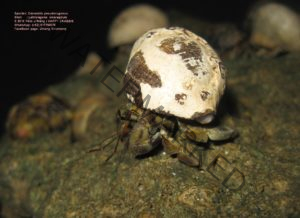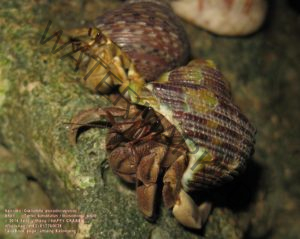
Common name: Pseudorugosus
Latin Origins: the Latin adjective rugosus (“wrinkled”), which itself derives from “ruga” (“wrinkle”)
Greek Origins: combining form of pseudḗs false, pseûdos falsehood
Distribution: Indo West Pacific Region. In Japan this species is recorded from Chichijima and Anijima Islands in Bonin Islands, Anami-Obshima, Okinoerabujima and Yoronjima Islands in the Amami Islands and from each island of Okinawa Prefecture except Kitadaitojima Island. Very abundunt in Oknawa Prefecture. [1] Central Indonesia – Celebes ( Sulawesi ) Island, West Nusa Tenggara Islands, and the Philippines. Madagascar[3], Maldives. They may also available in the eastern Indonesia ( Moluccas Island & around Papua )[2]
Habitat: tropical shore. Semi-desert water edge in SW Madagascar [3] The range of Coenobita species is higher up the shore than that of any other hermit crab, but the study species, particularly C. rugosus and C. pseudorugosus, differ little in habitat and zone occupation (Barnes 1997a). Hermit crabs are typically scavenging omnivorous detritivores with little or no obvious partitioning of food resources (Hazlett 1981). The coenobitid species studied are, likewise, highly opportunistic consumers of detritus on the strandline and similar food (Barnes 1997b). Food is, therefore, highly unlikely to be significant in reducing niche overlap.[4]
Ecology: Mostly nocturnal, supratidal, terrestrial
Larval Stages:
Characteristics: Pseudo rugosus is pink as juvenile and become dark red/dark pink/a part black when it matures. Eye stalks are elongated. Large pincer is flat on the bottom, stitch marks are less pronounced than on rugosus. The coloration of the large pincer is lacking the two distinct dark patches that is found on rugosus. The shield has a dark brown band behind the eyes.
Shield usually longer than broad, narrower anteriorly; anerior margin between rostrum and lateral projections concave; rostrum small and triangular; doral surface with scattered granules on anterior and lateral portions; and lateral margins setose.
Ocular acicle broad basally, triangular and terminating in a small spine. Antennular basal segment with very produced laminar portion proximally and vertical margin of its lamina making an obtuse angle with upper margin of segment; small flagellum of antennule reaching nearly to one-half length of large one. Antennal acicle fused with second segment of its penducle.
In left chelipeds palm with an oblique series of seven to ten up-standing laminar teeth on the upper part of the outer surface; lower margin of propodus nearly straight in distal half and not four-cornered in an external form; palm with scattered round granules in addition to oblique teeth on outer surface, numerous especially on its lower portions; both fingers also with numerous round granules on outer surfaces; inner surface of palm strongly elevated in middle part and covered with large scale-like tubercles; movable finger with corneous-tipped granules on inner surface. In small cheliped fingers and palm with corneous-tipped granules and setae on outer surfaces.
In left third leg outer surfaces of dactylus and propodus flat, smooth, and separated from dorsal surface by a well marked longitudinal crest; walking legs except left third leg with setae on lower margin of each sement. In male coaxe of fifth legs of both sides produced ventrally, unequal and aright coxa produced into an elongate tube, always longer than left one; its tube turning to the left and curved ventrally.
Small individuals with a broad dark brown transverse band at anterior one-third of shield and two longitudinal stripes of the same color on posterior portion. Large individuals sometimes with two dark brown patches behind anterior margin of shield. Side walls of shield with a dark brown transverse band on anterior part.

Ventral surface of ocular peduncle dark brown. Palm of left cheliped with a longitudinal white stripe on the middle portion and the other part dark-brownish. Carpi of first and third legs with a longitudinal dark brown stripe; meri with dark brown ring distally. [1]
What distinguishes Pseudorugosus from rugosus by the following characteristics: In the lower margin of the propodus of the large cheliped is nearly straight for the distal half and the palm is , therefore, not four-cornered in an external form; while the palm of rugosus has an obtuse corner and is thus four-cornered in an external form; the palm of the present species is dark-brownish, lacking a distinct large patch of dark brown on the outer surface, but that of rugosus has a distinct large patch of dark brown.[1]

In all the specimens of the male, the right sexual tube is distinctly longer than the left one, while in a great number of specimens of rugosus examined, the right sexual tube is almost equal in length to the left, or the right is slightly longer than the left. [1]

Common identifiers:
- Eyes – Stalks are elongated, dark spot on the front of the stalk
- Large claw – less distinct stitch marks that C. rugosus, dark patch is less distinct than C. rugosus claw, lower edge of claw is straight or half straight whereas C. rugosus is more round
- Coloring – may be lighter in SW Madagascar [3]
- Chirps – likely
Behavior:
Diet: omnivorous
Preferred shells: short spired [4]


C. pseudorugosus on Instagram
[insta-gallery id=”6″]
References:
1. Land hermit crabs from the Ryukyus, Japan, with a description of a new species from the Phillippines by Yukio Nakasone
2. Felix Wang
3. David Barnes short migrations
4.Ecology of subtropical hermit crabs in SW Madagascar: refuge-use and dynamic niche overlap David K. A. Barnes





